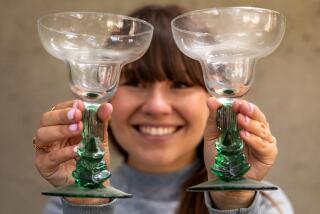Do I Hear $1,000?
- Share via
At commercial auctions, the goal is to move the wine. Auctioneer Ursula Hermacinski estimates that 1,200 lots of wine--mostly old and rare, almost all from the cellars of private parties who are selling off part or all of their collections--will be sold at Christie’s wine auction Saturday. She will dispose of about 171 lots of wine per hour. That’s a far cry from the two dozen (or fewer) per hour sold at the typical charity auction, where the biggest prizes are not wines but trips and dinners with winemakers.
The charity wine auction is a completely different phenomenon, says Bruce Kaiser, vice president and director of the wine department at Butterfield and Butterfield, a San Francisco auction house. “In a fund-raiser,” he points out, “you’re there to raise funds for the charity, so you [the auctioneer] can be a little lighter, have a bit of fun. In a commercial auction, things have to move along.
“At a commercial auction, you don’t want people to sit there all day long. It gets torturous after six hours. At a charity auction, you cajole, you talk, you plead, and you’re lucky to get through 20 lots an hour. So they last a lot longer. People are there to have a good time as well as buy a little wine and support the charity.”
Another difference between the two types of auctions is that the wines at commercial auctions are often far more rare than those at the typical charity auction. Jamie Ritchie, auctioneer for Sotheby’s, the other major London auction house, which also recently established a Southern California office (coincidentally, a block from Christie’s sale room), says a rare wine--or at least a full case of something rare--doesn’t usually turn up at charity auctions because the donors get nothing (except a tax benefit) for their donation to the charity.
But Kaiser notes that there are rarely bargains at charity auctions. Buyers get to claim part of their bid as a tax deduction because it is viewed as a contribution to the charity, so bids run higher than they would at a commercial auction. “Usually, there is little correlation between quality and the price something sells for at a charity auction,” says Kaiser. “Say a magnum of wine sells for $1,000 [at a charity event]. At a commercial auction, that same wine would sell for $300.”
The worst part of charity auctions, in Kaiser’s view, is that the winning bid for a particular wine often is seen as a real-world price. That gets other people with the same wine thinking they have something worth a lot of money. “Every time one of these charity auctions gets reported in the paper, people call and ask, ‘Can I sell my magnum for $1,000?’ ”
The best thing about the charity auctions? They really do wonderful work for important charities.
“That’s what makes it all so rewarding,” says Kaiser.


